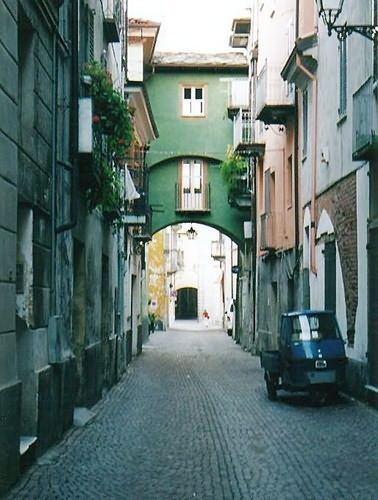Country Area 119 km2 | ||
 | ||
Mayor Federico Borgna (from 2012) | ||
Map of Cuneo
Cuneo ([ˈkuːneo] ; Piedmontese: Coni [ˈkʊni]; French: Coni [kɔni]) is a city and comune in Piedmont, Northern Italy, the capital of the province of Cuneo, the third largest of Italy’s provinces by area.
Contents
- Map of Cuneo
- The godfather the dons edition ps3 31 cuneo compound snub nose
- Europe 2007 part 20 cuneo and vernante
- History
- Main sights
- Subdivisions
- Climate
- Cuisine and food
- Volleyball
- Football
- Cycling
- Notable people
- Twinnings
- References
It is located at 550 metres (1,804 ft) in the south-west of Piedmont, at the confluence of the rivers Stura and Gesso.
Including all bordering municipalities Beinette, Borgo San Dalmazzo, Boves, Busca, Caraglio, Castelletto Stura, Centallo, Cervasca, Morozzo, Peveragno, Tarantasca and Vignolo the population is 123,301 inhabitants.
It is near six important mountain passes:
The godfather the dons edition ps3 31 cuneo compound snub nose
Europe 2007 part 20 cuneo and vernante
History
Cuneo was founded in 1198 by the local population, who declared it an independent commune, freeing themselves from the authority of the bishops of Asti and the marquisses of Montferrat and Saluzzo. In 1210 the latter occupied it, and in 1231 the Cuneesi rebelled. In 1238 they were recognized as free commune by Emperor Frederick II.
In 1259 the independence of Cuneo ceased forever, as it gave itself, also to take protection against its more powerful neighbours, to Charles I of Anjou, who was then King of Naples and Count of Provence. Together with Alba, it was the main Angevine possession in Northern Italy; their rule (in fact interrupted by periods under Saluzzo, Savoy, the Visconti of Milan) ended in 1382 when Cuneo was acquired by the Duchy of Savoy.
Cuneo became an important stronghold of the expanding Savoy state, and was thus besieged by France several times: first in 1515 by Swiss troops of Francis I of France, then again in 1542, 1557, 1639, 1641, 1691 and, during the War of Austrian Succession, in 1741. In all the sieges Cuneo resisted successfully. Cuneo was conquered by France only during the Napoleonic Wars, when it was made the capital of the Stura department. After the restoration of the Kingdom of Sardinia, and the unification of Italy, Cuneo became the capital of its namesake province in 1859.
During World War II, from 1943 to 1945, it was one of the main centres of partisan resistance against the German occupation of Italy.
Main sights
Subdivisions
Most important and populated: Centro storico, Cuneo centro, Cuneo nuova, San Paolo, Donatello, Gramsci, San Rocco, Cerialdo, Confreria and Borgo San Giuseppe.
Climate
Cuneo has a temperate sub-continental climate, with cold winters and hot, dry summers. However, it is situated more than 500 metres (1,640 feet) above sea level, which helps to make summers more bearable: the hottest month, July, has an average temperature of 21.6 °C (70.9 °F). The coldest, January, averages 1.7 °C (35.1 °F). Annual precipitation is about 962 mm (37.9 in), distributed over 81 days. The rainfall pattern is similar to that of Turin, with two maxima—one primary and one secondary (spring and autumn) and two minima (summer and winter). The driest month is July, 44 millimetres (1.7 in). Snowfalls are frequent owing to high elevation and wind patterns.
Cuisine and food
Cuneo's specialty is Cuneesi al rhum, chocolates with a unique rum-based filling. The most famous brand is Arione, located in Piazza Galimberti (the city's central square). Arione, founded in 1923, has kept its traditional furniture.
Volleyball
There is an important volleyball club, Piemonte Volley who won 1 Italian Volleyball League, 3 CEV Cup, 2 CEV SuperCup, 4 Italian Volleyball Cup and 3 Italian Volleyball SuperCup.
Football
Associazione Calcio Cuneo 1905 (A.C. Cuneo 1905) who plays in the 3rd level of Italian football.
Cycling
Many times stage of Giro d'Italia. In 2016, for the first time in the Giro history, the race has arrived in Sant'Anna di Vinadio sanctuary, the highest sanctuary in Europe, 2035 m, and the day after, on May 29, the race started from Cuneo. Since 1987 Cuneo has been the start and arrival point of the amateur international race "La Fausto Coppi".
Notable people
Twinnings
Cuneo is also twinned with the contrada della Selva of Siena, Italy.
